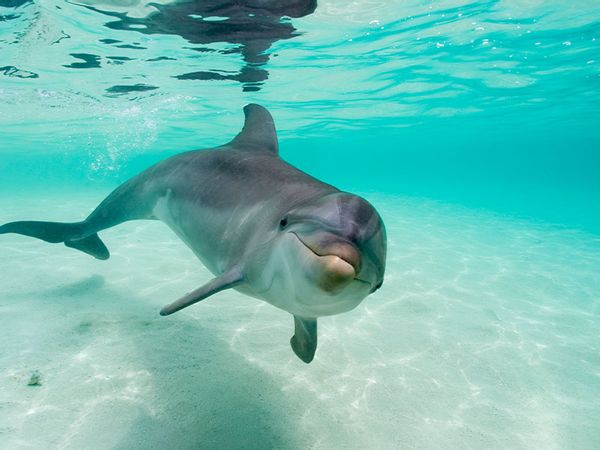Reports of dolphin warfare, marine mammal combat and sea assassins of the Kremlin this week have not been exaggerated. You may have even heard murmurs of the US' secret sea lion program in San Diego. Maybe you're wondering: Do they have lasers? (I was.) But who enlists such intelligent animals into warfare?
Don't worry. Even if all this sounds like fully unhinged geopolitical gibberish, it's assuredly real: Recent reports from British intelligence have alerted the world to Russia's latest military maneuver in its war against Ukraine: the recruitment and training of weaponized attack dolphins.
Here are the four most important (read: absurd) facts to share with your friends about the top-secret military use of dolphin warfare.
1. No, you're not losing your mind. Russia really does have attack dolphins.
The marine base in Sevastopol is Russia's central base in the Black Sea area and, as mentioned, British intelligence officials have recently relayed that Russia's secret attack-dolphin program there is doubling in size, with an eye toward defending against any Ukrainian enemy divers.
Russia's wariness of losing high-value Black Sea naval ships has been noted by defense analysts and US Naval Institute watchers since April 2022, when satellite photos captured new developments at the marine training center.
"The killer-dolphins would be trained to attack enemy combat swimmers using special knives or pistols fixed to their heads."
But according to the UK Ministry of Defense, the Russian Navy has been beefing up security at its base in occupied Crimea, enhancing its water-based defenses since last summer. The previously estimated two or three dolphins has now reportedly been upped to five or six, with evidence suggesting room for even further "recruitment."
Iuliia Mendel, a spokesperson for Ukrainian President Volodymyr Zelensky, explained the latest dolphin intelligence in a recent tweet: "Russia has almost doubled its floating mammal pens in Sevastopol, according to British defence officials, and is 'highly likely' to contain trained bottle nosed dolphins ... The Russian navy, which also uses Beluga whales and seals for missions, has invested heavily in its Black Sea Fleet's main base since last summer."
The latest image captures show two floating pens of the kind usually used for dolphin training at the mouth of the Sevastopol base in the Black Sea.
"This includes at least four layers of nets and booms across the harbour entrance. In recent weeks, these defences have highly likely also been augmented by an increased number of trained marine mammals," said the ministry in its statement.
That's right — Russia's got a secret combat dolphin program, with the aim of stopping Ukrainian enemy dive teams and protecting Russian ships. And yes, it gets weirder.
2. Ukraine's horny war dolphins once escaped, armed with head-knives
The real scoop here is that Russia's secret attack dolphins are swimming exactly where Ukraine's own sea assassins were once kept. Sevastopol was where the Soviet Union's secret military dolphin program began in 1973. Once the USSR collapsed, however, the dolphins and sea lions fell under Ukraine's command.
The Sevastopol combat dolphins remained under Ukraine control through the 1990s and the program saw something of a resurrection in 2012 — with the dolphins being trained to plant bombs on ships, hunt for mines and attack enemy divers. Then, in 2014, Russia annexed Crimea and Sevastopol. And with it, came the dolphins.
 Bottlenose Dolphin (Getty Images/Stuart Westmorland)Amid conflicting reports on the fate of the Ukrainian sea soldiers, Ukraine officials said that shortly after being captured by the Russians, the dolphins refused to be flipped and died "patriotically after going on a hunger strike."
Bottlenose Dolphin (Getty Images/Stuart Westmorland)Amid conflicting reports on the fate of the Ukrainian sea soldiers, Ukraine officials said that shortly after being captured by the Russians, the dolphins refused to be flipped and died "patriotically after going on a hunger strike."
Back in 2015, Russian state media reported that not only had Ukraine restarted its attack-dolphin efforts, but that five Ukrainian combat dolphins had gone rogue — busting out of their aquatic barracks for a little mating-season R&R. Two of the dolphins, apparently successful, came back after a couple of days — but the other three highly-trained marines remained AWOL on a sex bender, reportedly armed to the teeth.
"The killer-dolphins would be trained to attack enemy combat swimmers using special knives or pistols fixed to their heads," the Russian military source told Rio Novosti.
In the same report, former Soviet naval anti-sabotage officer Yury Plyachenko highlighted the surprisingly critical role the species played in combat areas, despite having a well-known lubricious streak.
"There were repeatedly cases in the 1980s when control was lost over dolphins," said Plyachenko. "If a male dolphin saw a female dolphin during the mating season, he would immediately set off after her and would no longer obey any commands. But in a week or so, he'd come back."
Ukraine's Ministry of Defense denied the report at the time, along with denying the restart of the combat dolphin program.
3. Yes, the US did have a classified military dolphin operation — because America.
The US tried to keep its own dolphin defense ops under wraps for decades, but finally the San Diego-based program was declassified in the 1990s. As the Navy's Marine Mammal Program has repeatedly said in official statements, the dolphins were largely used for sniffing out undersea mines and finding unauthorized swimmers in off-limits areas.
In an archived version of the Navy's FAQ, the animals are praised, along with sea lions, for their resistance to pressure-change sickness known as "the bends" that can be detrimental to human divers when resurfacing.
"The Navy currently relies on dolphins and sea lions to help protect lives and naval assets for two major reasons: their sensory capabilities and their diving capabilities. Dolphins naturally possess the most sophisticated sonar known to man. Mines and other potentially dangerous objects on the ocean floor are acoustically difficult targets to detect, especially in murky or dark water," the program said.
Of the sea lions, the Navy said they possess "excellent low light vision and underwater directional hearing capabilities. Sea lions are not only adept at locating objects in challenging conditions, they also have the ability to maneuver in tight spaces and can go onto the shore if necessary."
Since 2003, reports have continued to circulate more widely about the use of military dolphins as touted by the US. As of 2010, 80 bottlenose dolphins and 30 California sea lions were held by the Navy in San Diego Bay, according to The Seattle Times. And in 2012, retired Admiral Tim Keating told NPR that during the invasion of Iraq the US Navy had also used toothed whales to detect mines — though he wouldn't confirm whether the dolphins were also used in the Persian Gulf.
"I'd rather not talk about whether we used them or not. They were present in theater," Keating said.
There's also the matter of the US spending years trying to turn far less intelligent sharks into Cold War suicide bombers, as documented by Mary Roach in her book, "Grunt: The Curious Science of Humans at War."
But that's a dorsal of another color.
4. Russia is actually killing thousands of dolphins
There's a darker context to the Russian use of dolphins for war, however. As pointed out recently by UAnimals — an advocacy organization aimed at saving animals affected by the Ukraine invasion — the fallout of recent Russian waterway attacks has included devastating effects on marine wildlife.
Some marine biologists previously estimated as many as 50,000 Black Sea dolphins were killed as a result of Russia's invasion of Ukraine. As reported in May by USA Today, top ecology scientists in Ukraine report that more than 100 Black Sea bottlenose dolphins died in one month.
"Unfortunately, during April 2023, more than a hundred dead dolphins have already been registered in the bays of Sevastopol and other shores of the occupied Crimea and nearby Novorossyska, Sochi, Gelendzhik," said Ivan Rusev, Ukraine's research head at the Tuzly Estuaries National Park.
The fact that we drag other animals into our atrocious battles is yet another reason war is hell.



Shares